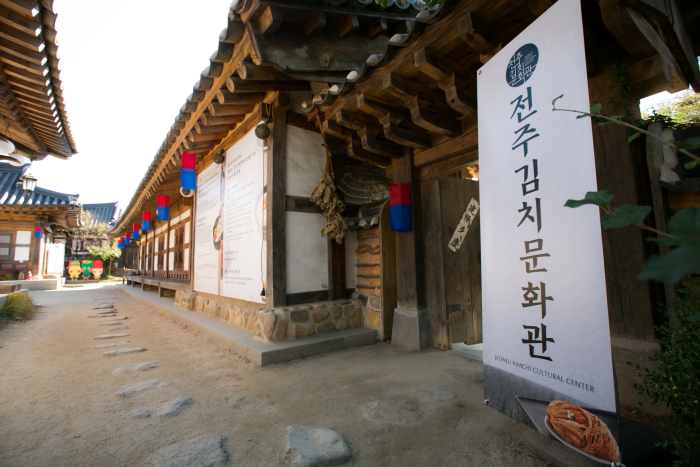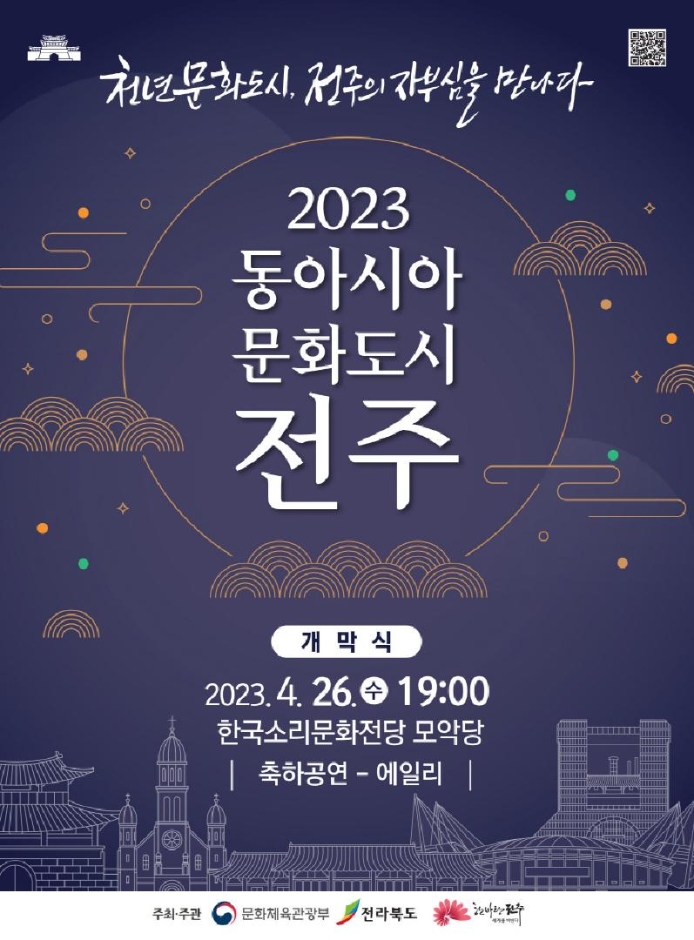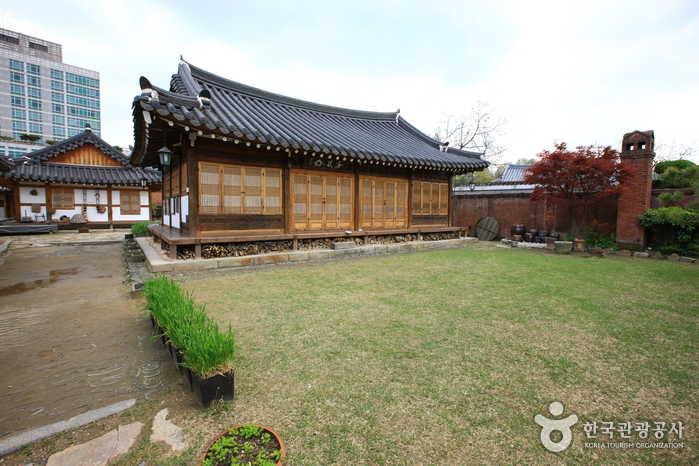Gaeksa-gil (객사길)
523.0599562154472m 0 2024-04-07
10-1 Jungang-dong 2(i)-ga, Wansan-gu, Jeonju-si, Jeonbuk-do
+82-63-282-1330
Gaeksa, which was installed in every town during the Goryeo and Joseon periods, was a type of accommodation where foreign envoys or government officials from other regions stayed. Gaeksa can still be seen today in downtown Jeonju and there's a "Gaeksa-gil Street" at the main street of the old city center. The street features countless roadside shops and franchise restaurants so both Jeonju locals and tourists frequently visit the area. Also, Jeonju Gaeksa-gil is where the Jeonju International Film Festival is held every year. Considered as one of the three main Korean film festivals, the Jeonju International Film Festival primarily presents independent films and has discovered many hit movies and new actors. On one side of Gaeksa-gil, you can also find Jeonju Cine Complex and several movie theaters, which is why it is called the "Film Street." In the back of the Film Street, restaurants, cafes and clothing shops attract movie fans to form so-called "Gaengnidan-gil."
Royal Portrait Museum (어진박물관)
530.7279976539984m 19472 2024-04-07
44, Taejo-ro, Wansan-gu, Jeonju-si, Jeonbuk-do
+82- 63-231-0090
Opened on November 6, 2010, the Royal Portrait Museum is one of the newest attractions of Jeonju, located within the Gyeonggijeon Shrine. Royal Portrait Museum is a valuable museum as a new tourism resource of Jeonju as well as Gyeonggijeon Shrine and the Portrait of King Taejo, as well as other various high-class exhibitions to preserve, manage, and enhance the glorious cultural assets of Joseon royal family. The museum is comprised of one above-ground level and one underground level with an area of 1,193.71 square meters. The Portrait of King Taejo and six other king’s portraits (Portrait of King Sejong, King Yeongjo, King Jeongjo, King Cheoljong, King Gojong, and King Sunjong) are exhibited on the first floor. The portraits are preserved in temperature- and humidity-controlled cases. In addition, the museum houses History Hall, Palanquin Hall, a planned exhibition hall, resting area, management office and storage room for relics. Palanquin Hall exhibits Hyangjeong (Palanquin for Incense Burner and Case), Sinyeon (Palanquin for Royal Portrait and Palanquin for Mortuary Tablet), Chaeyeo (Palanquin for High Officials), Gagyo (Palanquin for Ritual Items) featuring Korea’s sole preserved palanquin. History Hall houses approximately 80 relices related to Gyeonggijeon Shrine and Jogyeong Shrine, ancestral ritual ceremony, building, and others relics. Since the museum's opening, it makes continual efforts to become a central place for Jeonju residents to fulfill their cultural feelings. The museum operates various program like exploring famous historic sites in Gyeonggijeon Shrine, hands-on programs such as a guard experience to protect the shrine, and duplicating Gyeonggijeon Shrine’s relics using traditional portrait-making techniques.
Lloyd - NC Wave Jeonju Branch [Tax Refund Shop] (로이드 전주NC웨이브)
530.2891030952708m 0 2024-04-22
21-12, Jeonjugaeksa 5-gil, Wansan-gu, Jeonju-si, Jeollabuk-do
-
Jeonju Kimchi Cultural Center (전주한옥마을 전주김치문화관)
557.7553873948341m 29358 2024-04-07
29, Eojin-gil, Wansan-gu, Jeonju-si, Jeonbuk-do
+82-63-287-6300
Jeonju Kimchi Cultural Center is located in Jeonju, a UNESCO-designated City of Gastronomy. At the center, visitors can learn about the wisdom and science behind kimchi and Korean food culture.
Culture City of East Asia Jeonju (동아시아문화도시 전주)
562.9972408504617m 0 2024-04-07
213, Girin-daero, Wansan-gu, Jeonju-si, Jeonbuk-do
+82-63-281-6314
The Culture City of East Asia is an agreement to promote diverse cultural exchanges between Korea, China, and Japan. Under the value of respect for cultural diversity among Korea, China, and Japan, each year one city from each country is designated as a “Culture City of East Asia” to practice the spirit of “East Asian consciousness, cultural exchange and convergence, and understanding of other cultures.” (Source: Culture City of East Asia website)
Jeonju Hanok Village [Slow City] (전북 전주 한옥마을 [슬로시티])
576.8595203591058m 280674 2024-05-27
99 Girin-daero, Wansan-gu, Jeonju-si, Jeonbuk-do
+82-63-282-1330
Jeonju Hanok Village is comprised of some 700 beautiful hanok buildings, and is Korea's largest, and only urban, traditional hanok village. The village started in the early 1900s around the areas of Gyeonggijeon Shrine, Omokdae, and Jeonjuhyanggyo Confusian Academy - all important cultural heritages. To experience what hanok is like, visitors can either book a hanok accommodation or visit the Hanok Life Experience Hall.
PoongNamheon [Korea Quality] / 풍남헌 [한국관광 품질인증]
593.8851310794832m 8159 2024-04-07
35 , Eunhaeng-ro, Wansan-gu, Jeonju-si, Jeonbuk-do
+82-63-286-7673, +82-10-2757-7673
Pungnamheon is a hanok stay in a traditional nobleman's house in Jeonju, Jeollabuk-do. Next to the house stands a 600-year-old ginkgo tree, the guardian spirit of Jeonju Hanok Village. Two unusual features of this hanok is that there is no wood-floored hall or daecheong, and the toenmaru wooden porch is extra wide, and has a window. The floors are finished with laquered hanji (Korean paper), and the roof tiles were made in Goryeong. Old folding screens and Korean paintings complete the atmosphere of a traditional yangbang house. Guests have a chance to taste wild green tea gathered and made by the owner.
Save Zone - Jeonju Core Branch [Tax Refund Shop] (세이브존 전주코아점)
601.0982090959224m 0 2024-04-22
262-6, Paldal-ro, Wansan-gu, Jeonju-si, Jeollabuk-do
-
Dong Nak Won [Korea Quality] / 동락원 [한국관광 품질인증]
604.2781146603699m 219 2024-04-07
33-6 , Eunhaeng-ro, Wansan-gu, Jeonju-si, Jeonbuk-do
+82-63-287-9300, +82-10-4951-9300
Dongnagwon is a hanok hotel in Jeonju Hanok Village, Jeollabuk-do. It was built as a memorial hall for the missionary William Junkin, who founded a school mission in Jeonju in 1895. Now refurbished as a hotel and venue for traditional performances, wedding ceremonies and seminars, visitors will find old-style interiors with antique furniture and folding screens. Guests can play traditional games in the yard, and there is a red clay room to relieve the fatigue of travel, free of charge. Mountain bikes can be borrowed to ride around the Hanok Village or on the banks of the Jeonjucheon Stream.
Dongnagwon House (동락원)
624.7366700235364m 13096 2024-04-07
33-6, Eunhaeng-ro, Wansan-gu, Jeonju-si, Jeonbuk-do
+82-63-285-3490
The Dongnagwon House in Jeonju Hanok Village provides a getaway to experience hanok stay and traditional Korean life. Affiliated with Jeonju Kijeon College, Dongnagwon is also a memorial hall dedicated to W. M. Junkin, who came to Korea as a missionary from the South Presbyterian Church of the United States in 1892. Dongnagwon is a reproduction of the old hanok houses in Jeonju from the time when W. M. Junkin was doing his missionary work in the area. It is
comprised of three buildings: Anchae (main hall), Sarangchae (guest house), and Haengnangchae (servants’ quarters).
Visitors to Dongnagwon can learn and experience traditional Korean culture such as music, crafts, and dance while inhabiting traditional lodging. In addition to providing accommodation for individual guests, Dongnagwon is also used for group accommodations or activities such as seminars, conferences, and family events. For groups of 30 or more, it is possible to rent out the entire venue (in addition to all facilities, including Seungdokdang, Seunghwadang, Cheongyuje, and the front yard).




![Jeonju Hanok Village [Slow City] (전북 전주 한옥마을 [슬로시티])](http://tong.visitkorea.or.kr/cms/resource/67/2654567_image2_1.jpg)
![PoongNamheon [Korea Quality] / 풍남헌 [한국관광 품질인증]](http://tong.visitkorea.or.kr/cms/resource/73/3022073_image2_1.jpg)
![Save Zone - Jeonju Core Branch [Tax Refund Shop] (세이브존 전주코아점)](http://tong.visitkorea.or.kr/cms/resource/63/2886363_image2_1.jpg)
![Dong Nak Won [Korea Quality] / 동락원 [한국관광 품질인증]](http://tong.visitkorea.or.kr/cms/resource/16/2595016_image2_1.jpg)

 English
English
 한국어
한국어 日本語
日本語 中文(简体)
中文(简体) Deutsch
Deutsch Français
Français Español
Español Русский
Русский